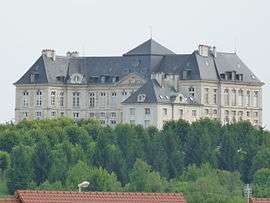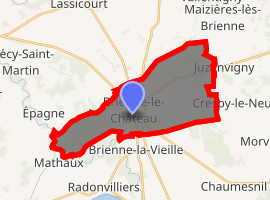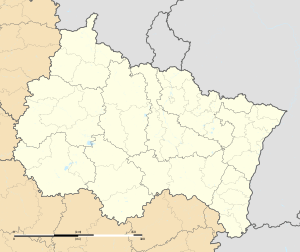Brienne-le-Château
Brienne-le-Château (French pronunciation: [bʁijɛnləʃato]) is a commune in the Aube department in north-central France. It is located 1 mile (2 km) from the right bank of the river Aube and 26 miles northeast of Troyes.
Brienne-le-Château | |
|---|---|
 The chateau in Brienne-le-Château | |
 Coat of arms | |
Location of Brienne-le-Château 
| |
 Brienne-le-Château  Brienne-le-Château | |
| Coordinates: 48°23′31″N 4°31′35″E | |
| Country | France |
| Region | Grand Est |
| Department | Aube |
| Arrondissement | Bar-sur-Aube |
| Canton | Brienne-le-Château |
| Government | |
| • Mayor (2008–2014) | Nicolas Dhuicq |
| Area 1 | 21.56 km2 (8.32 sq mi) |
| Population (2017-01-01)[1] | 2,826 |
| • Density | 130/km2 (340/sq mi) |
| Time zone | UTC+01:00 (CET) |
| • Summer (DST) | UTC+02:00 (CEST) |
| INSEE/Postal code | 10064 /10500 |
| Elevation | 112–167 m (367–548 ft) (avg. 126 m or 413 ft) |
| 1 French Land Register data, which excludes lakes, ponds, glaciers > 1 km2 (0.386 sq mi or 247 acres) and river estuaries. | |
History
It was the centre of the medieval County of Brienne, whose lords, first counts and eventually dukes, had a claim to the Kingdom of Jerusalem. John of Brienne ( c. 1170 – 27 March 1237), also known as John I, was King of Jerusalem from 1210 to 1225 (and Latin Emperor of Constantinople from 1229 to 1237). He was the youngest son of Erard II of Brienne, a wealthy nobleman in Champagne.
The École de Brienne was established in 1730 and remained active until it was closed in 1790. It is currently a museum. Notable students included:
- Napoleon Bonaparte (1779 to 1784) (French Emperor)
- Władysław Franciszek Jabłonowski (1783) (Polish general)
- Louis-Nicolas Davout (French Marshal)
- Antoine Le Picard de Phélippeaux
In 1814, it was the site of the Battle of Brienne, when the Sixth Coalition invaded France.
Population
| Year | Pop. | ±% |
|---|---|---|
| 1793 | 1,968 | — |
| 1800 | 1,967 | −0.1% |
| 1806 | 1,859 | −5.5% |
| 1821 | 1,747 | −6.0% |
| 1831 | 1,920 | +9.9% |
| 1836 | 2,002 | +4.3% |
| 1841 | 1,830 | −8.6% |
| 1846 | 1,886 | +3.1% |
| 1851 | 1,880 | −0.3% |
| 1856 | 2,013 | +7.1% |
| 1861 | 2,057 | +2.2% |
| 1866 | 2,078 | +1.0% |
| 1872 | 1,886 | −9.2% |
| 1876 | 1,889 | +0.2% |
| 1881 | 1,918 | +1.5% |
| 1886 | 1,872 | −2.4% |
| 1891 | 1,732 | −7.5% |
| 1896 | 1,701 | −1.8% |
| 1901 | 1,753 | +3.1% |
| 1906 | 1,872 | +6.8% |
| 1911 | 1,815 | −3.0% |
| 1921 | 1,708 | −5.9% |
| 1926 | 1,932 | +13.1% |
| 1931 | 2,218 | +14.8% |
| 1936 | 2,232 | +0.6% |
| 1946 | 1,972 | −11.6% |
| 1954 | 2,177 | +10.4% |
| 1962 | 3,534 | +62.3% |
| 1968 | 3,939 | +11.5% |
| 1975 | 4,033 | +2.4% |
| 1982 | 4,060 | +0.7% |
| 1990 | 3,752 | −7.6% |
| 1999 | 3,332 | −11.2% |
| 2008 | 3,142 | −5.7% |
| 2012 | 2,987 | −4.9% |
See also
- Communes of the Aube department
- Parc naturel régional de la Forêt d'Orient
References
- "Populations légales 2017". INSEE. Retrieved 6 January 2020.
References
